Although vocoders are mainly used to make music, they weren’t invented for that purpose.
The idea behind a vocoder is to synthesize vocals using any available sound which serves to reduce the bandwidth of voice.
Reducing the bandwidth of voice information was initially intended to make phone calls travel further.
The reduced quality at the time, however, didn’t give the idea much credibility.
On the other hand, vocoders were used to send hidden messages over long distances in World War II.
Not exactly the greatest purpose but it worked nevertheless.
So how did a device that people used in war manage to become a music-maker?
What Is a Vocoder?
In simple words, a vocoder is a synthesizer that can change your voice or convert other sounds into what sounds like a voice.
The vocoder was developed by Homer Dudely in 1928.
Unfortunately, the quality of the voice output was too bad for the vocoder to serve its actual purpose.
The technology just wasn’t advanced enough at the time.
Nowadays, the most common use of vocoders is using synthesized voices to make music.
You can use a vocoder to make yourself sound robotic, or you can also use it to make the sounds of random elements sound like a voice.
With some training and skill, you could create some crazy (and often great) songs with the vocoder.
It takes a bit of learning to grasp the vocoder’s potential and use it to make music, so it’s worth understanding how it works first.
How Does a Vocoder Work?

A vocoder uses two main audio sources to work; the carrier and the modulator.
You may not easily understand the difference between them but we’ll simplify it as much as possible.
The carrier is the initial, unedited sound that goes inside the vocoder. Think of it as the raw sample of sound before tweaking it.
The modulator is where most of the magic happens.
Through something called the filter bank, the modulator uses different filters and effects on the carrier.
Those filters have varying pitches, volumes, frequencies, and degrees.
By mixing them together, you’re able to project the outcoming noise on different sound frequencies than the incoming one.
Still here? Let’s use a simple example.
When you attempt to say something, the air comes out of your lungs and vibrates your vocal cords. This is the carrier.
If you choose not to move your tongue or lips, the noise you make will make no sense to anyone.
When you add the modulator (your tongue and your lips) to the mix, you start to “modify” that sound into understandable words.
The difference between our example and the vocoder is that the carriers are not always incomprehensible.
You can input some normal words and apply a filter on them or you can input some random sounds and synthesize voice using them.
By understanding how to play around with the carriers and modulators, you can get some cool creations out of the vocoder.
How Can a Vocoder Make Music?
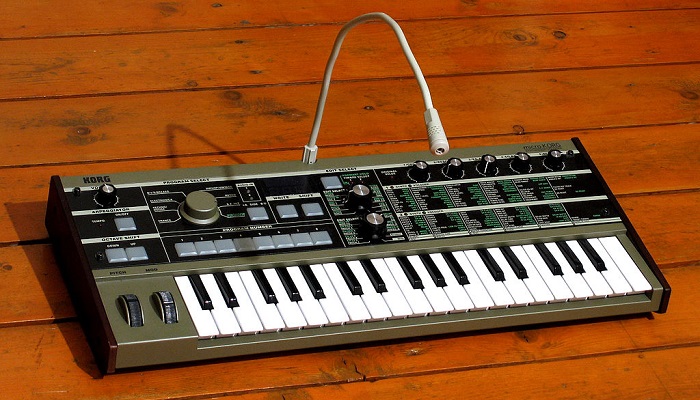
This is probably why you are here today.
Vocoders can make music by tweaking certain filters and settings and applying them to the incoming sound.
With a little practice, you can create your own music using a vocoder at home.
Vocoders have various settings that you can use to make music.
You need to familiarize yourself with the basic settings before you can push your music-making further.
Bands
A band is essentially a measuring unit that’s used to determine the frequency of the sound in real-time.
Most vocoders will let you decide how many bands you want to use in your audio.
The more bands you have in your audio, the more realistic your sound will seem. Conversely, using fewer bands will make the sound seem more synthetic.
There’s no correct or ideal number of bands in the audio.
However, most people use vocoders to make the sound seem more digital, so a lower number of bands is often used by vocoder users.
Formant
Formant, by definition, is the quality of speech sound. In a vocoder, the formant setting allows you to control the quality of each individual band.
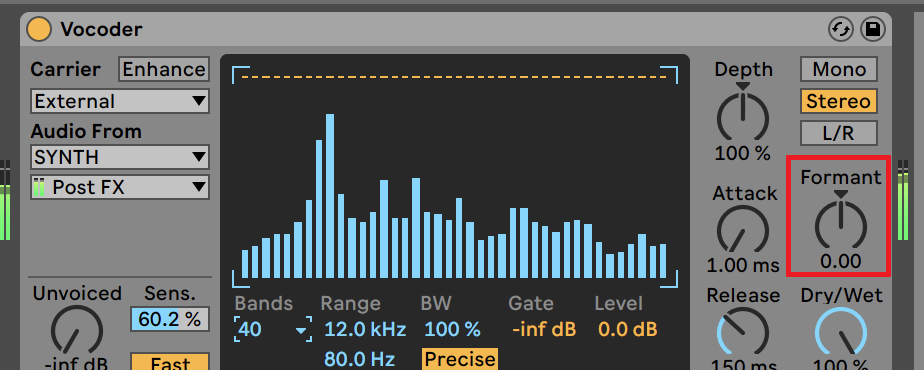
Controlling each band allows you to make the sound higher or deeper without changing the pitch.
You can still change the pitch to make your audio sound deeper and higher.
The thing is, the formant offers the advantage of not changing the pitch which in turn keeps the frequency of your audio unchanged.
When your frequency remains the same, the ear hears the sound more comfortably.
Constant changes in the pitch could cause headaches and ear pain and thus, gaining the ability to mimic the change in pitch without actually changing the frequency is a good advantage.
Filter
Filters are tools that allow you to alter a voice or a sound. Vocoders have many filters that you can experiment and play around with.
In vocoders, filters can be applied to the incoming signals or the outcoming ones.
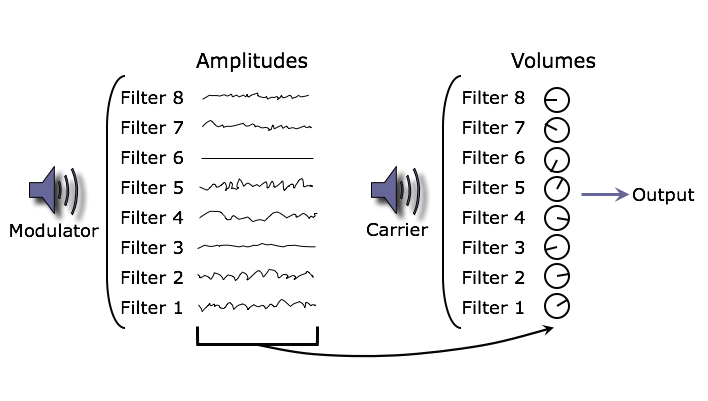
Filtering the incoming signal allows you to prevent the vocoder from picking up undesired frequencies.
For example, if there’s a highly-pitched noise in the background that you don’t want the vocoder to detect while recording, you can simply exclude that frequency.
On the other hand, the output filter allows you to filter the unwanted frequencies before the synth’s output.
The final product may sometimes sound different depending on whether you filtered the unwanted frequencies in the input or the output.
Try experimenting with this and see which sound quality you prefer.
Unvoiced
The unvoiced vocoder setting allows you to help the vocoder detect certain speech consonants.
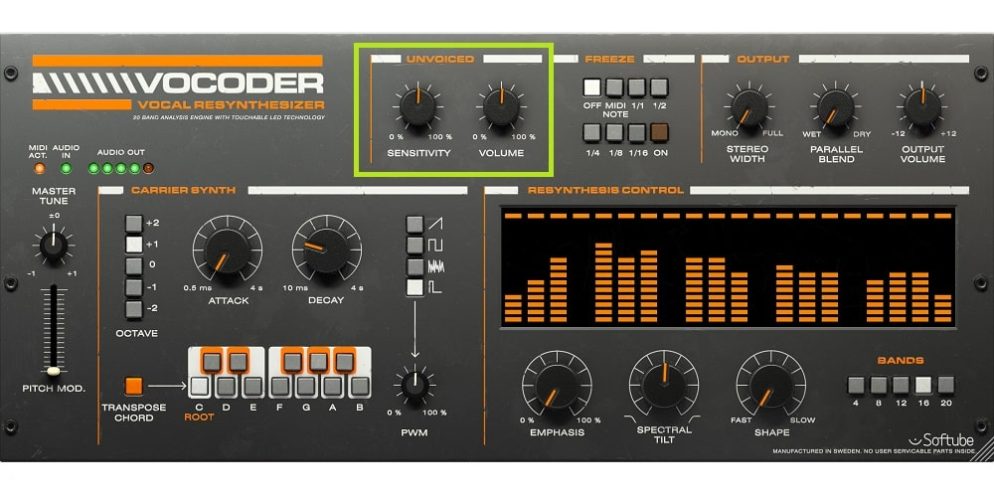
Vocoders sometimes have trouble picking up plosives and sibilants and the unvoiced settings recreate these consonants when the vocoder fails to decipher them.
Did you manage to take all that in? Let’s slow down.
A plosive is the speech sound that comes from certain letters like T, K, P, D, G, and B.
Sibilant is a speech sound that comes out when the tongue approaches the roof of the mouth to produce a hissing-like sound.
Examples of those letters are S, Z, SH, and ZH.
Vocoders sometimes have trouble deciphering plosives and sibilants because the letters come out of our throats using similar mechanisms.
Unvoiced settings allow the vocoder to recreate those sounds when the vocoder fails to detect them correctly.
Oscillators
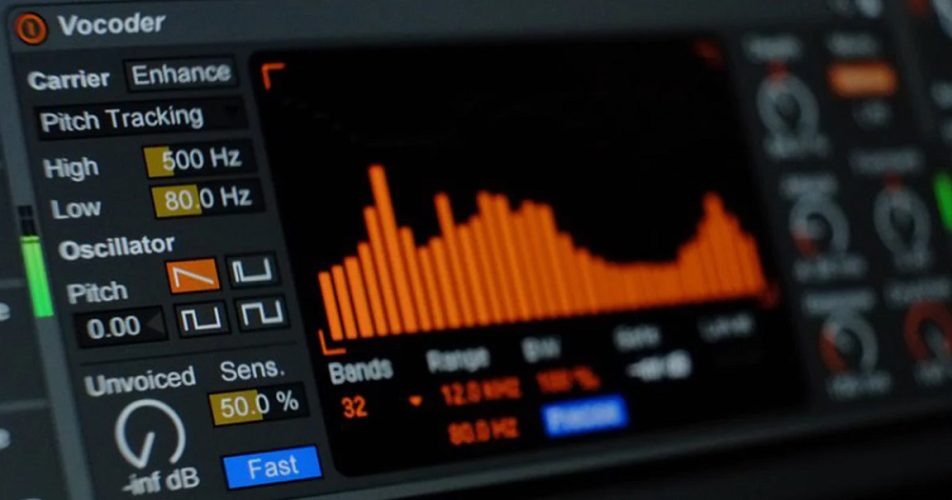
Oscillators are the main reason why vocoders give out that iconic synthetic sound. They work by creating waveforms.
The sound or voice you input in the vocoder modulates those waveforms and makes them mimic the incoming sound.
Most vocoders often have more than one oscillator at the same time.
To get the best quality of sound, it’s best to have at least one of those oscillators pitched a degree or two higher than its peers.
Noise Oscillators
If you’re into synthetic sounds, you’ve mostly noticed the static background noise that goes with the metallic sound.
Noise oscillators are the ones responsible for that.
It’s best to take care while using noise oscillators as they could completely distort your music especially if it has vocals in it.
How to Use a Vocoder?

Vocoders can be used to synthesize sound from any sound source. However, they’re mostly used in vocals.
So, when you input your vocal sound, make sure to use more bands.
Anything over 10 bands should give you a good quality of your voice and allow the lyrics to be heard.
The further you go ahead of 10 bands, the more normal the voice will seem.
Experiment with bands to find that sweet spot between heart lyrics and synthetic sound.
Dial in the unvoiced setting to make sure those hard-to-detect consonants are also detected by the vocoder.
If you are using your own voice to record the vocoder input, you should try to be as clear as possible while saying the words.
You can even go the extra mile and over-articulate the words. Try to say the words more clearly than how you would in a normal conversation.
Think of it as if you’re speaking to a child and don’t worry about the output.
The final result will be very different from your original voice anyway and you can even speed up the words if you find out later that you’re talking too slow.
You may or may not add some noise to the sound. There’s no right or wrong here and the choice is up to you
Keep in mind that the vocals you use could be background vocals.
When you use a vocoder for background vocals, the background voice should add to the original voice, not take over it.
To avoid making the background vocals too focal, don’t use the noise oscillators as they help make the lyrics more recognizable.







